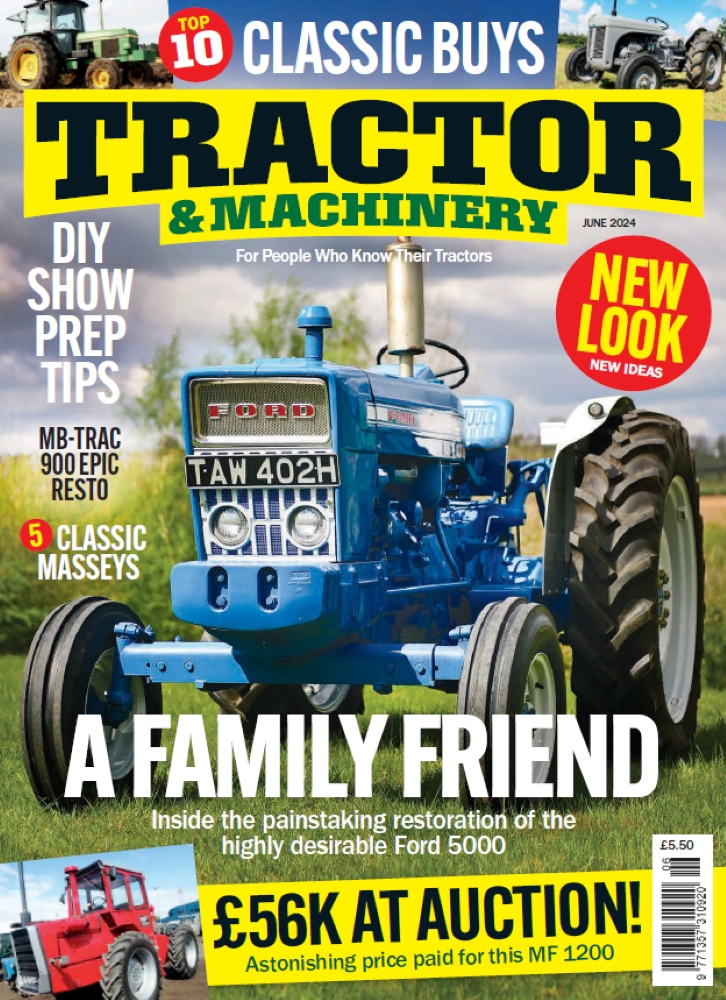Classic 1970s balers from International Harvester
Posted by Chris Graham on 28th August 2024
Johnathan Whitlam champions the International Harvester 440 and 445 balers – a couple of classic machines from the 1970s.

International Harvester balers: This would have been many a tractor driver’s dream outfit back in the 1970s; a Ford 7000 with its turbocharged 94hp and an IH 445 baler and sled; a baler that many consider as one of the best of its generation in terms of usability and reliability. Happily this tractor and baler are still in use together today.
Seeing an immaculate International Harvester 445 conventional baler at work behind an equally immaculate Ford 7000 tractor is a sight guaranteed to transport those of us over a certain age back to a time when the small, square baler was king.
International Harvester built one of the most popular ranges of ‘conventional balers’ in Yorkshire during the 1970s and early ‘80s, with the 440 and 445 models widely regarded as the best the company ever produced. Of course, International Harvester wasn’t the first to make pick-up balers, but it was early into the market in North America and went on to build many thousands of units at its factory in Doncaster.
TRUSSERS TO BALERS
The mechanical baler grew out of the need for straw to be packed into easy-to-handle and convenient-to-store packages that could then be used by housed livestock during the wet and cold winter months. The first examples were stationary units that packed straw fed to them by a threshing machine, and were belt-driven by traction engines originally, then pulley-equipped tractors, and they used wire to tie the compacted bales together.
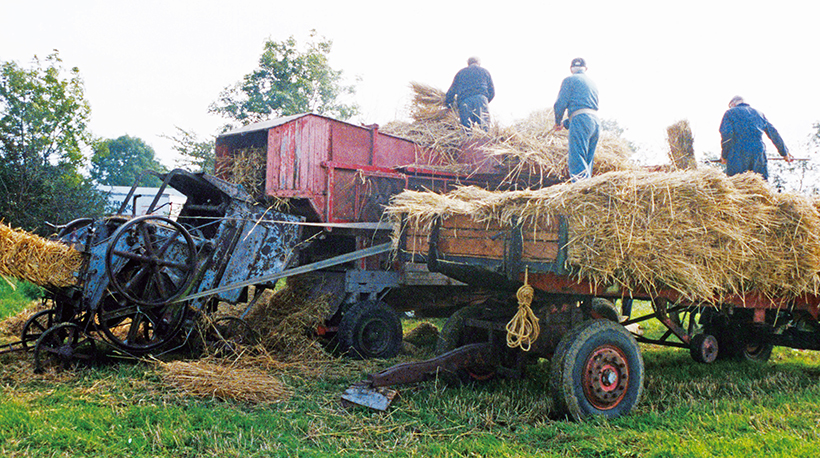
A straw trusser forming bales as it’s fed from the rear of a threshing machine. These were the first types of balers, being replaced by larger machines that produced higher-density bales.
These early machines were called ‘bunchers’ or ‘trussers’, and were small devices that made looser packs of straw than we are used to today. Soon they became mobile, typically being fitted to the back of a combine harvesters such as the early trailed machines, then the self-propelled harvesters. But the bales remained low-density until larger, stationary machines appeared that used a packer arm to compress the straw into a rectangular package within a bale chamber. These balers were also used to produce hay bales by feeding in material from hay ricks.
But it was the first pick-up balers that really made a significant difference to the baling of straw, and also the hay-making process, by producing small, rectangular bales that could be easily moved and stored, even by hand.
PICK-UP BALER ARRIVES
The idea of a tractor-drawn pick-up baler was first seen in America, with the early machines – such as the New Holland Automaton Model 73 – being one of the first to use twine instead of wire to tie the bales. These machines became more common on this side of the Atlantic during the 1940s, with America’s New Holland and Claas from Germany dominating the UK market which they shared with home-grown machines such as those produced by Jones, based in Wales.

A once-typical haymaking scene as a David Brown 995 and International Harvester 440 baler with sled take a break on a warm day on the marshes on the Suffolk/Norfolk border.
By this stage, overall baler design started to become standardised, with the various makes adopting an offset pick-up that allowed the tractor to drive next to the swathe of straw or hay, with power for the baler coming either from the tractor’s PTO shaft or the baler’s own engine. Machines such as the Massey-Harris 701 were even available with the choice of either vaporising oil or diesel engines. Gradually though, as tractor power outputs increased, balers all became PTO-driven.
By the late 1950s, British farmers had plenty of choice with regard to baler manufacturers, although the market-leading machines of the day came from Massey Ferguson, New Holland and International Harvester.
McCORMICK BALERS
International Harvester produced its first pick-up baler in America during 1940. Called the McCormick Deering No. 15, the machine used wire to tie the bales and needed two people to operate it, making it a rather unwieldy piece of kit. Then, in 1944, the McCormick Deering No. 50-T arrived. It was the company’s first twine-tying, pick-up baler and was powered by its own 14hp, four-cylinder IH engine and was the first of its type to be imported into the UK.
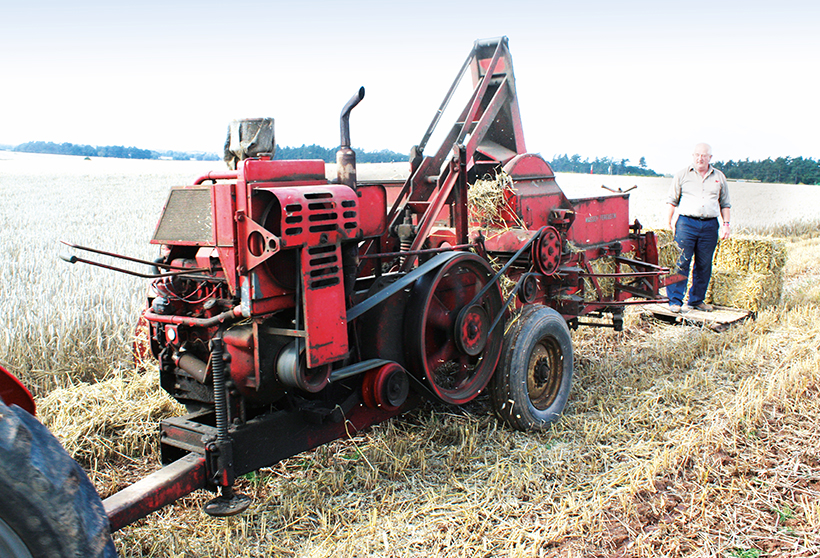
An older type of Massey Ferguson baler – the 701 – complete with its own power source, the tractor only having to pull the machine rather than also power it. This taller type of baler design, first seen as a Massey-Harris, was the norm before sleeker, more compact balers arrived during the 1960s.
British-built International Harvester balers then appeared from 1950, produced in the large factory in Doncaster, with the B45 baler being based on the American-built No. 45. The B45 was a PTO-driven, medium-density baler with a cross-feed auger and packers feeding the straw or hay into its bale chamber. Diesel or petrol engines were available as a power source as an optional extra but, by this time, most farmers opted for the PTO version as it kept the purchase cost down.
In 1956 IH introduced the B55 as a heavy-duty machine, available with either wire twisters or twine knotters, although twine was fast becoming the preferred option for most UK farmers. The B46 replaced the original B45 in 1960, offering a higher bale output and, in 1965, the B47 model took efficiency to an even higher level.
1970s AND ’80s BALERS
By the mid-1970s, International Harvester had produced what would, to many people, become the quintessential IH baler. The B45 and B47 had been extremely popular and reliable but, with the new 440, the company really struck gold! Not only was the machine sleek and efficient, but it was capable of baling 20 tons of material an hour, making it ideal for larger farms and contractors. It also had a wide enough pick-up to cope with straw swathes from the largest combine harvesters of the day.

A Massey Ferguson 703 pick-up baler, one of the first, more compact designs from this company that went on to be a major force in the UK baler market during the 1950s and ‘60s.
The 440, with its 65-inch wide pick-up reel, was certainly a big machine but, for those who didn’t need such a sizeable baler, the identical 430 offered a narrower pick-up that was better suited to farmers working with smaller combines and narrower swathes.
The success of the 430 and the 440 led to further design refinements and the arrival of the 425 and 435 models, plus the flagship 445 by the end of the 1970s. Twine had become the standard option, although a wire-twister version could still be ordered. The 435 and 445 were very similar, having a 14 x 18in bale chamber producing bales of up to 44 inches long. Bale length was controlled by a metering wheel and both models were available with twine or wire tying.
A timed needle action separated the bales, which were sliced by an angled plunger knife against an angled stationary knife, with a knife-to-knife clearance maximum of 0.030 inches. The balers used a flywheel friction drive and the plunger worked at 75-85 strokes per minute. Power came from the tractor’s PTO with 540-610rpm being required for successful operation.
A spring finger-type pick-up was used, with the 445 having six bars, and the 435 four. The 445 utilised 132 tines while the 435 had 76, and the pick-up widths varied from 65.3 inches for the 445, and 57.2 inches on the 435. Obviously, the 445 was a larger machine at 104 inches wide compared to the 435’s 96in overall width. But both models shared the same length and height measurements, at 191 inches and 58.5 inches, respectively.
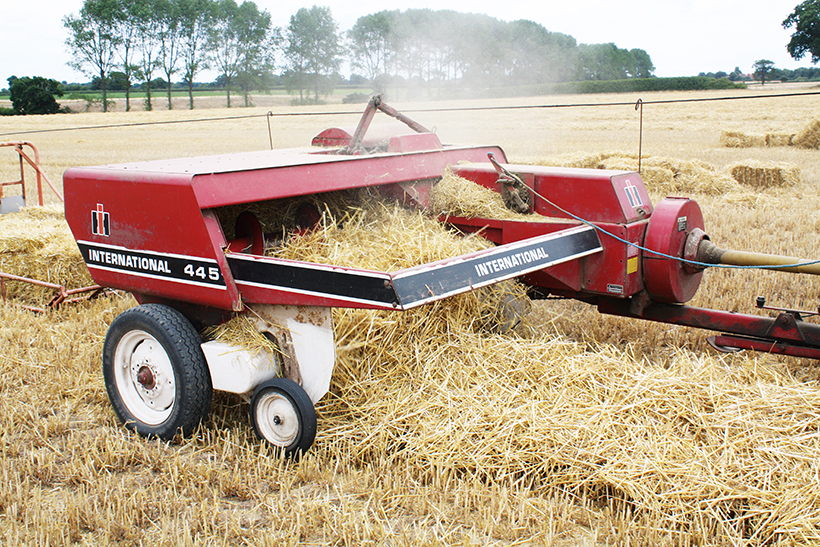
The packing arm can be clearly seen on the top of this 445 baler, which packs the straw into the bale chamber.
The list of optional equipment for these balers included a bale chute attachment which made it easier to load bales directly onto a trailer towed behind the baler; a sledge hitch attachment to make use of a bale sledge with a suitable hitch plate at the rear of the bale chamber; a wide-wheel attachment to replace the smaller, standard left wheel for operation over soft ground. Another item that was listed under ‘special equipment’ was a floating pick-up wheel attachment, designed to maintain a proper relationship between the pick-up spring teeth and the ground to guide the pick-up cylinder over field irregularities or obstructions. The 445, like the 440 before it, proved to be the most popular baler in Britain although, in France, a 445D version was built, complete with Deering-type knotter.
By this stage, though, baler production was starting to slow at the Doncaster factory. Things drew to a close with the 500 Series, but this never replicated the sales popularity of the earlier machines as, by the mid-1980s, demand for conventional square balers was falling. It was at this time that the last machines were produced under the new Case IH regime, following the merger between JI Case and International Harvester, after the purchase of IH by Tenneco, in 1985.
IH BALER FAN
Farmer Graham Richmond has a lifetime of experience with International Harvester square balers and still owns and uses one today. His small farm in Suffolk was established by his grandfather, and it was his father who first used a Claas buncher before moving on to a Massey Ferguson 703 baler.

Graham Richmond baling straw with his Ford 7000 and International Harvester 445 baler in Suffolk. This Ford 7000 soon became the main baling tractor on the farm and was more than powerful enough thanks to its 94hp, turbocharged engine. Square balers were quite power-hungry, and the packer arm used such force that the whole rig – including the tractor – would move backwards and forwards due to the momentum; particularly apparent when the outfit was stationary but still working.
During the 1960s Graham’s father switched to a B46 baler and was immediately impressed by the much higher output compared to the MF 703. Graham wasn’t a fan of the new hydraulic bale tensioner, though, recalling that it was a pain to get bales out manually when encountering a problem, as there was no way to release the tension.
Following on from their original B46, the Richmonds then owned several B47 balers in succession. By that stage the farm was also undertaking a lot of contract baling on top of its own work, so the balers were kept for no more than two years before being traded-in for new replacements.
“The B47 balers seemed to vary a great deal in quality over the years,” Graham told me, “and the biggest weakness was always with the knotters, which needed constant adjustment while at work.” In fact, he typically had to completely rebuild the knotters several times during the baling season, using new parts. Eventually he became so adept at the task that he was able to set them up ‘by eye’, in the field!
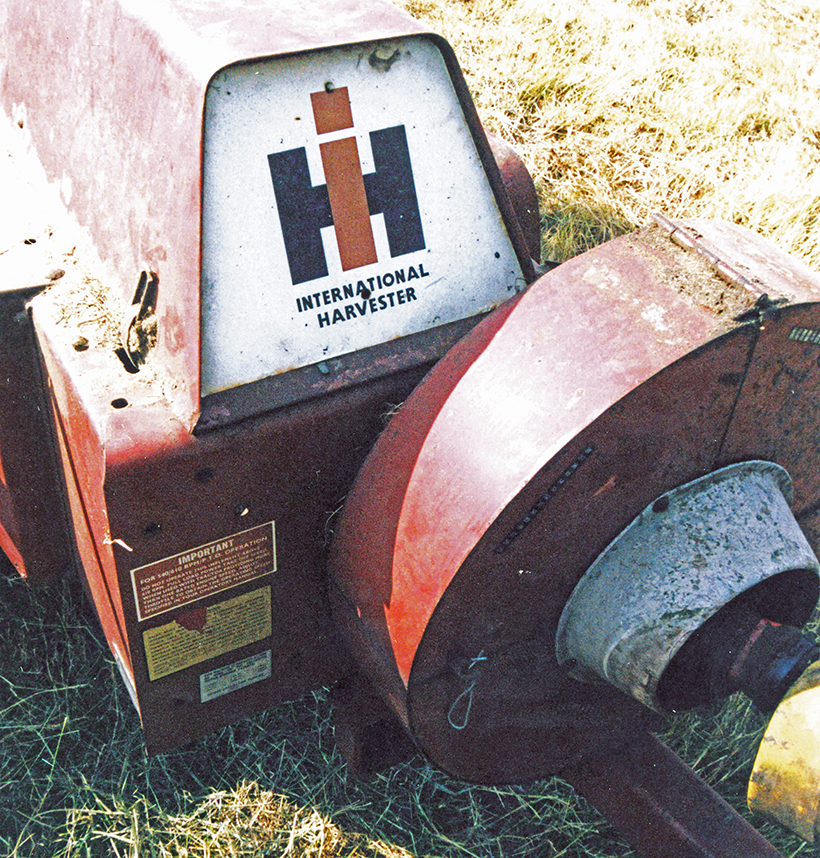
The International Harvester name and logo displayed prominently on the front of the baler, above the power take-off drive. For many years, ‘McCormick’ was used more prominently than ‘International Harvester’ on the equipment produced by the company.
Then there came the day, in the 1970s, when the first new generation International Harvester 440 baler arrived on the farm, replacing the last of the B47 machines. Graham considered the new model to be a great improvement over the B47, especially with its wider pick-up, although initial problems necessitated a repair under warranty. But, once this was sorted, the 440 became well thought of, particularly regarding its much better knotter set-up, although one of the 440s the Richmond’s used did ‘chew up’ all its gears while in use.
The 440 was eventually swapped for a 445, which is still on the farm today. With a wider pick-up and narrower tines than on the 440, Graham found this model much better for following larger combine harvesters that were producing wider swathes, although it was just as easy to use as the earlier 440.
Graham certainly used his IH balers well. During one memorable season he produced 52,000 hay and straw bales which, in turn, consumed two-and-a-half tons of twine! Understandably, he remains a great fan of IH balers, and particularly appreciated the fact that they were shaft- and gear-driven, rather than relying on chains like the machines from Massey Ferguson and New Holland.
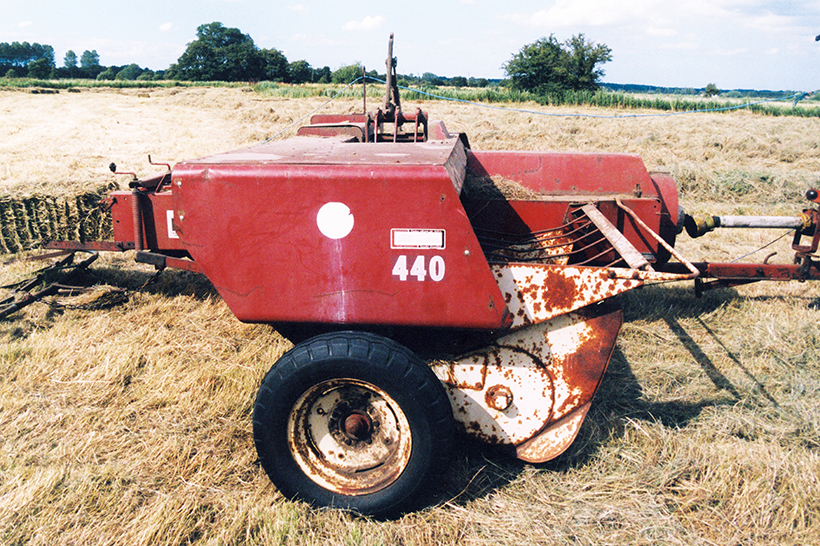
The 440 was a very popular baler in the UK, used by many farmers who had a substantial amount of baling work to do each season. As the largest baler in the IH product line up until the mid-1970s, it was seen as the best machine for large farm operators and contractors.
For those considering buying an IH 440 or 445 baler secondhand today, Graham offers the following advice. “Always check how much work the baler has done, and the bale packers for general condition. Unfortunately, though, the only way to really tell how good a baler is, is to get it out and use it. Until then, you can never really be sure!
“I’d also say that those fitted with an auger-feed are better than tine-feed examples, and that buyers should make sure that the shaft drive is carefully checked together with the condition of the knotters – these are the very heart of the machine.”
BEGINNING OF THE END
The 1970s and early ’80s were a halcyon time for the square baler, with the British market alone being dominated by machines from the likes of Bamford, Claas, John Deere, Massey Ferguson, Welger, Vicon and, as we’ve seen, International Harvester.
The first round balers began to appear at the beginning of the 1980s, but the conventional square balers hung on gamely. However, the advent of big balers, such as the Howard and the American Hesston machines that produced much larger, square bales – as well as the growing popularity of large, round balers – signalled the beginning of the end for the conventional-type machines.
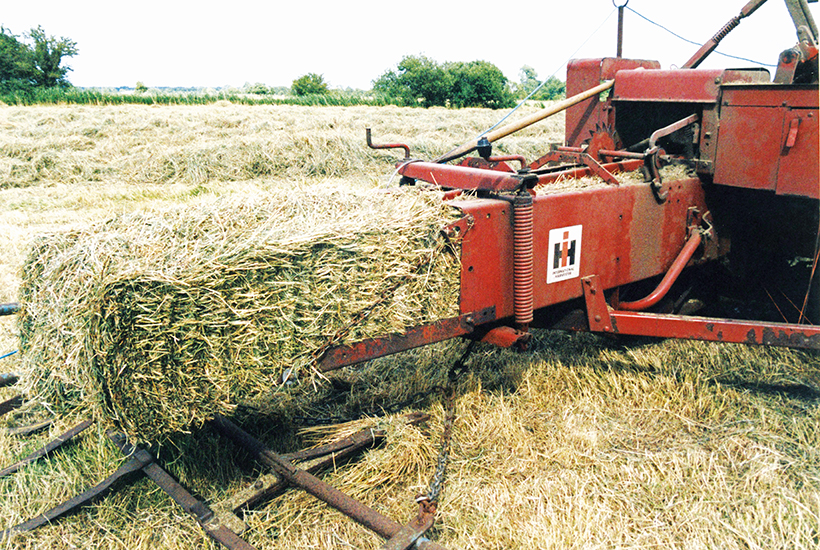
A bale leaving the rear of the IH 440 baler, showing the metering wheel and density adjusting handles.
By the 1990s the sales decline for the small square baler had become terminal, although the machines themselves lived on. Many farmers preferred the smaller, easier-to-handle, square bales, as did the ever growing number of horse owners. For this reason there’s still a demand for machines like the International Harvester 440 and 445 today, with many continuing to produce hay and straw bales on holdings across the land.
The conventional-type square pick-up baler was a success for over six decades and continues to be, even though not many are still being produced nowadays. Luckily, the old balers were of such a rugged and practical design that a huge number are still in active use each summer in Britain and I, for one, am glad this is the case. Few things remind me of the summer months more than the sound of a bale packer’s ram working away as a baler, such as the IH 445, packs hay or straw into small, rectangular bales.
This feature comes from the latest issue of Tractor & Machinery, and you can get a money-saving subscription to this magazine simply by clicking HERE
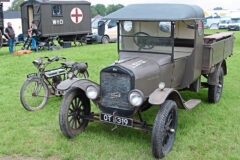
Previous Post
Interesting commercials at the Bath & West Show

Next Post
1967 Bedford KM lorry superbly restored as tribute



